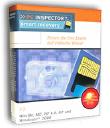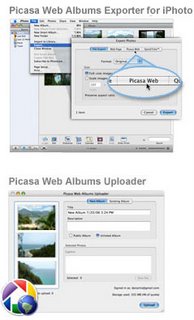You know it's going to happen to you eventually and most of us toddle along, not thinking it'll be today, but someday it will be and unless you've done something about it you're going to be very, very upset. That iPhoto album you've been working on for years or that large iTunes library - all gone, vanished when your hard drive started making clunkety-clunk noises and then died.
Okay, the more astute of you will have uploaded your photographs, important files, bookmarks, etc. to some online services like
Flickr and
del.icio.us and will say "my iTunes music is on my iPod", I don't need to back it up. Yes, in some cases they're right and that data can be restored but it'd be a long and tedious process to do it all like that. It's much faster to restore from a local backup so if you've got an external or second hard drive and can't wait for Apple to release their new Mac OS x 10.5 (Leopard) with its integrated backup application,
Time Machine, or stump up hard cash for a copy of
Retrospect, then there are a few free or very low cost tools that will let you do just that.
Apple's Disk Utility comes with Mac OS X and the current version allows you to make basic clone images of any drive. It also comes with built-in Restore functionality that can restore from another hard drive, an image or even from a URL. You'll need to boot from the Mac OS X install CD/DVD, or another external bootable drive, and run Disk Utility from there to do it though and it's a pretty slow process. If you want something a little less drastic and more flexible then here you are…
 BackityMac
BackityMac is a useful looking, freeware backup utility that'll backup your application preferences, documents and home folder. Supported important files include Apple Mail, MS Entourage, iCal, Address Book, Safari, Firefox, Camino, iPhoto, iTunes and iWeb.
The backing up process writes the data to a read-only disk image, then you can select this disk image within BackityMac and it functions as an auto-restore of your files. If you register it for a small fee, it'll be able to burn those images out to CD or DVD. It's well maintained and updated so is worth a look.
 Backuplist+
Backuplist+ is a freeware tool that uses
rsync, an open-source utility that provides fast incremental file transfer, to do the job and it can automatically backup system and application preferences as well as files and folders. It basically builds up sets of files, from which you can exclude items.
It will automatically collect all the important system and application preferences for backup as well. There are many other options including single compressed archives or Burn folders ready for making CD or DVD hard copies and you can schedule daily or weekly backups.
 iBackup
iBackup is a fairly simple to use backup and restore utility and it's the one I'm currently using as the application and plug-ins (see below) are updated regularly.
It supports scheduled backups of files, folders and applications. Furthermore, it uses plug-ins to allow you to backup settings like the dock, desktop picture, time, firewall, Bluetooth and other system preferences. It's also able to backup application preferences via these plug-ins, which are really just file location descriptors and you can write them yourself if you can't find the one you need in the list provided.
 SuperDuper
SuperDuper is an excellent shareware tool that started life some years ago as a floppy disk duplication tool and very good it was too. Nowadays, with the demise of the floppy drive, it has evolved into a decent backup and restore solution.
You can run it unlicensed with the publishers consent and it'll do basic hard drive cloning and restoring operations but buy a license and it unlocks scheduling, Smart Update (which saves a lot of time), Sandboxes, scripting and more.
There are a couple of older backup tools still around and, while they may not have seen much in the way of recent development and aren't
Universal Binaries, they may still have some value…
Carbon Copy Cloner is an old favourite and was often used to make images for later deployment to multiple systems using its sister utility
NetRestore. The developer is still working on it and NetRestore has been upgraded to a Universal Binary but it's perhaps fallen slightly by the wayside as NetRestore can also use images created with Apple's Disk Utility.
RsyncX is a freeware implementation of rsync with HFS+ support and configuration through both command line and graphical user interface. It's a comprehensive suite of file management tools and not specifically a backup and restore tool but it can be used as one. It can copy or update files, folders or volumes from one location to another. It can push a copy or update of any volume (including the boot drive) to another location. It's scriptable and you can set up an event schedule. It even comes with some useful wizards to make things easier.
 The service is still in beta testing but I've signed up and first impressions are very good indeed. All you need is a compatible Javascript capable browser and you're off and writing. Basically it's an online WYSIWYG editor but it's a lot more than just that. You can…
The service is still in beta testing but I've signed up and first impressions are very good indeed. All you need is a compatible Javascript capable browser and you're off and writing. Basically it's an online WYSIWYG editor but it's a lot more than just that. You can…






 is a free application for viewing Microsoft Project files. It reads Project files saved as XML data and supports Gantt, resource and calendar views.
is a free application for viewing Microsoft Project files. It reads Project files saved as XML data and supports Gantt, resource and calendar views.

 is yet another way to let non Windows users view Microsoft project files. This is a demo of a web server product that provides an online viewing service to corporate customers. However, it's free and may well do the job if you want to view small (up to 400k) project files and/or are running non-Windows systems.
is yet another way to let non Windows users view Microsoft project files. This is a demo of a web server product that provides an online viewing service to corporate customers. However, it's free and may well do the job if you want to view small (up to 400k) project files and/or are running non-Windows systems.






